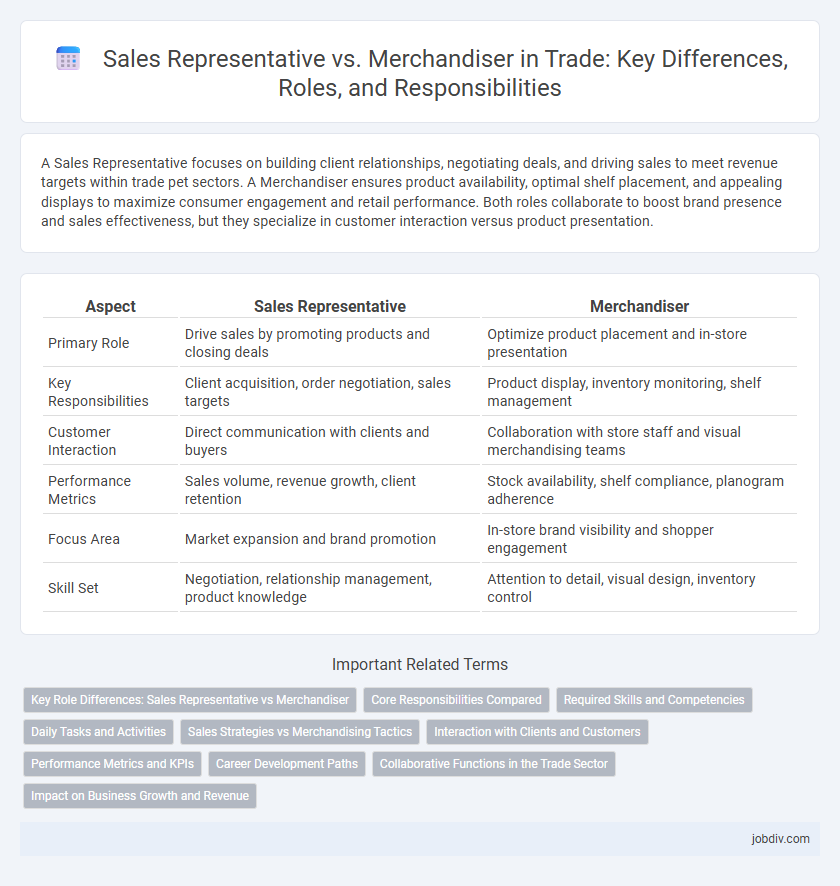A Sales Representative focuses on building client relationships, negotiating deals, and driving sales to meet revenue targets within trade pet sectors. A Merchandiser ensures product availability, optimal shelf placement, and appealing displays to maximize consumer engagement and retail performance. Both roles collaborate to boost brand presence and sales effectiveness, but they specialize in customer interaction versus product presentation.
Table of Comparison
| Aspect | Sales Representative | Merchandiser |
|---|---|---|
| Primary Role | Drive sales by promoting products and closing deals | Optimize product placement and in-store presentation |
| Key Responsibilities | Client acquisition, order negotiation, sales targets | Product display, inventory monitoring, shelf management |
| Customer Interaction | Direct communication with clients and buyers | Collaboration with store staff and visual merchandising teams |
| Performance Metrics | Sales volume, revenue growth, client retention | Stock availability, shelf compliance, planogram adherence |
| Focus Area | Market expansion and brand promotion | In-store brand visibility and shopper engagement |
| Skill Set | Negotiation, relationship management, product knowledge | Attention to detail, visual design, inventory control |
Key Role Differences: Sales Representative vs Merchandiser
Sales Representatives focus on driving revenue by building client relationships, negotiating deals, and closing sales to meet targets within specific territories. Merchandisers specialize in product placement, inventory management, and in-store promotions to maximize product visibility and optimize consumer purchasing behavior. The key role difference lies in Sales Representatives prioritizing customer acquisition and retention, while Merchandisers concentrate on enhancing product appeal and shelf presence.
Core Responsibilities Compared
Sales representatives focus on building client relationships, negotiating contracts, and closing sales to drive revenue growth. Merchandisers concentrate on product presentation, inventory management, and ensuring optimal shelf placement to maximize product visibility and sales. Both roles collaborate closely but emphasize distinct core responsibilities essential for successful trade operations.
Required Skills and Competencies
Sales Representatives require strong interpersonal communication, negotiation skills, and customer relationship management to effectively drive revenue and close deals. Merchandisers must possess analytical abilities, attention to product placement, inventory management skills, and a keen understanding of market trends to optimize in-store displays and maximize sales impact. Both roles benefit from proficiency in sales software and data interpretation, but the Sales Representative focuses more on client engagement while the Merchandiser emphasizes visual merchandising and stock control.
Daily Tasks and Activities
Sales Representatives focus on building client relationships, conducting product presentations, and negotiating contracts to drive sales growth. Merchandisers analyze market trends, manage product displays, and ensure optimal stock levels to enhance customer appeal and maximize store profitability. Both roles require coordination with supply chain teams but differ in emphasis on direct sales outreach versus in-store product promotion.
Sales Strategies vs Merchandising Tactics
Sales representatives deploy targeted sales strategies such as relationship building, product presentations, and negotiation techniques to drive revenue and secure customer loyalty. Merchandisers implement merchandising tactics including product placement, inventory management, and promotional displays to optimize product visibility and enhance consumer buying behavior. Both roles synergize to increase market penetration and maximize overall sales performance.
Interaction with Clients and Customers
Sales Representatives engage directly with clients to understand their needs, negotiate contracts, and close deals, emphasizing personalized communication and relationship building. Merchandisers focus on the in-store presentation, stock levels, and product placement to influence customer buying behavior and ensure product availability. Both roles collaborate to enhance customer satisfaction and drive sales, but the Sales Representative's interaction is more consultative, while the Merchandiser's is more operational and visual.
Performance Metrics and KPIs
Sales Representatives are primarily evaluated based on sales volume, conversion rates, and customer acquisition metrics, reflecting their ability to generate revenue and build client relationships. Merchandisers are assessed through inventory turnover, shelf compliance, and planogram adherence, which measure their effectiveness in product placement and stock management. Both roles utilize KPIs such as sales growth and market penetration, but performance metrics differ to emphasize revenue generation for sales reps and visual merchandising optimization for merchandisers.
Career Development Paths
Sales representatives typically advance by honing client relationship management, mastering product knowledge, and expanding territories to boost revenue, often progressing into sales management or business development roles. Merchandisers develop expertise in market analysis, inventory optimization, and visual merchandising, leading to opportunities in category management, retail operations, or supply chain coordination. Both career paths benefit from strong communication skills and strategic planning but diverge in focus: sales representatives prioritize customer acquisition and retention, while merchandisers concentrate on optimizing product placement and sales performance.
Collaborative Functions in the Trade Sector
Sales representatives and merchandisers in the trade sector collaborate closely to optimize product visibility and drive revenue growth. Sales representatives focus on building client relationships and closing deals, while merchandisers ensure strategic product placement and inventory management in retail environments. Effective collaboration between these roles enhances market penetration, customer satisfaction, and overall sales performance.
Impact on Business Growth and Revenue
Sales Representatives drive business growth by directly engaging customers, closing deals, and expanding market reach, resulting in immediate revenue increases. Merchandisers enhance revenue indirectly by optimizing product placement, inventory levels, and in-store promotions, which boost sales conversion rates and customer satisfaction. Both roles are crucial for maximizing overall sales performance and sustaining long-term business growth in competitive markets.
Sales Representative vs Merchandiser Infographic

 jobdiv.com
jobdiv.com